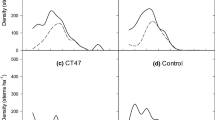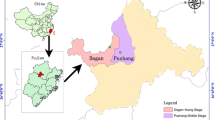Abstract
We analyzed data from 28 long-term experimental monitoring plots installed in Japanese cedar (Cryptomeria japonica D. Don) plantations in northeastern Japan to examine how site productivity and thinning practices relate to culmination in stand growth. Site productivity and thinning practices in the plots were evaluated by site index (dominant tree height at 40-years old) and by cumulative thinning rate (cumulative thinning volume divided by cumulative gross production during the entire period of measurement). Culmination of stand growth was evaluated by culmination age of the mean annual increment (MAI) and its maximum value (Max MAI). Max MAI for the mean annual gross increment (MAIgross) and mean annual net increment (MAInet) increased with increasing site index, but did not change with cumulative thinning rate. Culmination age for MAIgross decreased with increasing site index, but did not change with cumulative thinning rate. Culmination age for MAInet decreased with increasing site index. Additionally, culmination age for MAInet increased with increasing cumulative thinning rate in sites with a high site index (>19.3 m) but not in those with a low site index (<19.3 m). These results indicate that thinning extends the culmination age without changing Max MAInet under high site productivity. Therefore, thinning increases total net yield in sites with high productivity based on a long-term perspective.









Similar content being viewed by others
References
Amateis RL, Radtke PJ, Burkhart HE (1996) Growth and yield of thinned and unthinned plantations. J For 94:19–23
Ando T (1968) Ecological studies on the stand density control in even-aged pure stands. Bull Gov For Exp Stn Tokyo 210:1–153
Assman E (1970) The principles of forest yield study. Pergamon Press, New York
Breiman L, Friedman J, Olshen RA, Stone CJ (1984) Classification and regression trees. Chapman & Hall, New York
Curtis RO (1995) Extended rotations and culmination age of coast Douglas fir: old studies speak to current issues. Res Pap PNW-RP-485. USDA Forest Service, Pacific Northwest Research Station, Portland
Forest Planning Section, Japan Forestry Agency (1970) Tree volume table for eastern Japan. Japan Forestry Investigation Committee, Tokyo
Fownes JH, Harrington RA (1990) Modeling growth and optimal rotations of tropical multipurpose trees using unit leaf rate and leaf area index. J Appl Ecol 27:886–896
Fukuda M, Iehara T, Matsumoto M (2003) Carbon stock estimates for Sugi and Hinoki forests in Japan. For Ecol Manage 184:1–16
Hotta M (1928) Forest mensuration. Miura Shoten, Tokyo
Jaccard J, Turrisi R (2003) Interaction effects in multiple regression. Sage Publications, Thousand Oaks
Japan Forestry Agency (1980) Stand density control diagram for Cryptomeria japonica: national forest in the Akita District. Japan Forest Technology Association, Tokyo
Japan Meteorological Agency (2002) Mesh climate data for 1971–2000 (CD–Rom). Japan Meteorological Business Support Center, Tokyo
Kosaka J, Terazaki Y, Tsuzuki K, Kon T (1967) Thinning method from the perspective of stand growth. Trans Meet Jpn For Soc 78:60–61
Kunisaki T, Waragaya N, Shibata N (1999) Stand structure and growth of an old Cryptomeria japonica stand at the base of Mt. Iwate, northern Japan. J Jpn For Soc 81:346–350
Lindh BC, Muir PS (2004) Understory vegetation in young Douglas-fir forest: does thinning help restore old-growth composition? For Ecol Manage 192:285–296
Long JN, Dean TJ, Roberts SD (2004) Linkage between silviculture and ecology: examination of several important conceptual models. For Ecol Manage 200:249–261
Maindonald J, Braun J (2007) Analysis and graphics using R: an example-based approach. Cambridge University Press, New York
Marshall DD, Curtis RO (2002) Levels-of-growing-stock cooperative study in Douglas-fir: report 15-Hoskins: 1963–1988. Research Paper PNW-RP-537, USDA Forest Service, Pacific Northwest Research Station, Portland, p 80
Martin TA, Jokela EJ (2004) Stand development and production dynamics of loblolly pine under a range of cultural treatments in north-central Florida, USA. For Ecol Manage 192:39–58
Masaki T, Mori S, Kajimoto T, Hitsuma G, Sawata S, Mori M, Osumi K, Sakurai S, Seki T (2006) Long-term growth analyses of Japanese cedar trees in a plantation: neighborhood competition and persistence of initial growth deviations. J For Res 11:217–225
Nagaike T, Hayashi A (2004) Effects of extending rotation period on plant species diversity in Larix kaempferi plantations in central Japan. Ann For Sci 61:197–202
Nishizono T, Sawata S, Awaya Y (2006) Structure and growth in an old-growth sugi (Cryptomeria japonica) forest in Akita Prefecture, northeastern Japan. J Jpn For Soc 88:8–14
Nishizono T, Tanaka K, Awaya Y, Oishi Y, Hayashi M, Yokota Y (2008) Age-related changes in stand volume growth of Cryptomeria japonica plantations in Akita District, northeastern Japan. J Jpn For Soc 90 (in press)
Osumi K, Mori M, Sakurai S, Saitou K, Satou S, Seki T (2000) Long term growth records of old-aged sugi (Cryptomeria japonica) plantations in Akita Prefecture, north-eastern Japan. J Jpn For Soc 82:179–187
Osumi S (1955) Yield tables and growth in Japanese cedar forests. In: Sato Y (ed) Study on Japanese cedar. Yokendo, Tokyo, pp 387–424
Otomo E (1983) Characteristics of stand growth in Japanese cedar forest: inter-specific comparison. In: Everything about Japanese cedar. National Forestry Extension Association, Tokyo, pp 486–501
R Development Core Team (2006) R: a language and environment for statistical computing. R Foundation for Statistical Computing. http://www.R-project.org/
Ryan MG, Yoder BJ (1997) Hydraulic limits to tree height and tree growth. Bioscience 47:235–242
Ryan MG, Phillips N, Bond BJ (2006) The hydraulic limitation hypothesis revisited. Plant Cell Environ 29:367–381
Sakurai S (2002) Long rotation plantations: their function and silvicultural practices. Japan Forest Technology Association, Tokyo
Sawata S, Nishizono T, Awaya Y, Nobori Y (2007) Analysis of stem growth pattern in Japanese cedar (Cryptomeria japonica) trees in a natural forest in Akita, northeastern Japan. J Jpn For Soc 89:200–207
Seiwa K (1990) Changes of stand volume increments with stand age in Larix leptolepis. Trans Meet Hokkaido Branch Jpn For Soc 38:53–55
Smith FW, Long JN (2001) Age-related decline in forest growth: an emergent property. For Ecol Manage 144:175–181
Suzuki T (1979) Forest taxation. Asakura Shoten, Tokyo
Tadaki Y, Shidei T (1963) Ecological studies on quantitative thinning. Bull Kyoto Univ For 34:1–31
Takezawa K (2006) Introduction to nonparametric regression. Wiley, Hoboken
Tange T (1995) Ecophysiological study on the growth of Cryptomeria japonica planted trees. Bull Tokyo Univ For 93:65–145
Terazaki Y, Kosaka J, Kon T (1964) On the development and yield of sugi (Cryptomeria japonica D. Don): even-aged stands in the Akita District. Bull Gov For Exp Stn Tokyo 168:1–306
Yoda K, Kira T, Ogawa H, Hozumi K (1963) Self-thinning in overcrowded pure stands under cultivated and natural conditions. J Biol Osaka City Univ 14:104–129
Zhang J, Oliver WW, Powers RF (2005) Long-term effects of thinning and fertilization on growth of red fir in northeastern California. Can J For Res 35:1285–1293
Acknowledgments
We thank the staff members of the Tohoku Research Center, Forestry and Forest Products Institute, and Tohoku Regional Forest Office who installed permanent plots at the research site and maintained them over the long term. Masahide Hayashi, Keiko Izumi, Yasuhiro Yokota, Tomomasa Amano, Hirofumi Kuboyama, Kazushige Yamaki, and Hiromichi Furuido assisted in the recent fieldwork. We also thank Shigejiro Yoshida, Nobuya Mizoue, and anonymous reviewers for their careful reading of this article and insightful comments. A part of this study was supported by the Global Environment Research Fund of the Ministry of Environment as a research project on the Influence of Environmental Changes and Forest Management Practices on CO2 Sequestration of Conifer Plantations.
Author information
Authors and Affiliations
Corresponding author
About this article
Cite this article
Nishizono, T., Tanaka, K., Hosoda, K. et al. Effects of thinning and site productivity on culmination of stand growth: results from long-term monitoring experiments in Japanese cedar (Cryptomeria japonica D. Don) forests in northeastern Japan. J For Res 13, 264–274 (2008). https://doi.org/10.1007/s10310-008-0082-8
Received:
Accepted:
Published:
Issue Date:
DOI: https://doi.org/10.1007/s10310-008-0082-8




